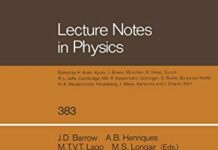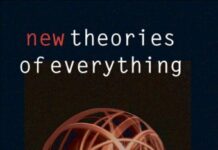
Ebook Info
- Published: 2009
- Number of pages: 433 pages
- Format: PDF
- File Size: 1.07 MB
- Authors: John D. Barrow
Description
What conceptual blind spot kept the ancient Greeks (unlike the Indians and Maya) from developing a concept of zero? Why did St. Augustine equate nothingness with the Devil? What tortuous means did 17th-century scientists employ in their attempts to create a vacuum? And why do contemporary quantum physicists believe that the void is actually seething with subatomic activity? You’ll find the answers in this dizzyingly erudite and elegantly explained book by the English cosmologist John D. Barrow.Ranging through mathematics, theology, philosophy, literature, particle physics, and cosmology, The Book of Nothing explores the enduring hold that vacuity has exercised on the human imagination. Combining high-wire speculation with a wealth of reference that takes in Freddy Mercury and Shakespeare alongside Isaac Newton, Albert Einstein, and Stephen Hawking, the result is a fascinating excursion to the vanishing point of our knowledge.
User’s Reviews
Reviews from Amazon users which were colected at the time this book was published on the website:
⭐John Barrow’s work is truly nifty and represents well-researched and designed material, that can stand on it’s own.If you have already read popular science cosmology books by Kip Thorne, Igor Novikov, Martin Rees or Alan Guth (just a few excellent examples – check my reviews), “The Book of Nothing” will still deliver new and fresh angle through which mysteries of quantum and Universe can be looked at. Therefore I recommend this book to all cosmology readers.Book is unique as a blend of tasteful dissertations from the realms of theology, philosophy, mathematics and cosmo – science. We will discover Mayan culture, Islamic art and Babylonian concept of zero, meet and learn what they thought or discovered – Greek philosophers, Hindus, Leibniz, Galileo, Pascal, Descartes, Newton/Einstein, Godel, Lemaitre, Plank, Guth, Linde, and Penrose/Hawking.The main theme (regardless if this was cosmology part of the book or not) is vacuum, and more exactly: it’s energy.Vacuum is not empty due to quantum phenomena and vacuum presents itself as a LAMBDA force, dominating, according to what we observe, the current behaviour of visible Universe.Especially interesting are author’s summaries about famous question: “Why is there something rather than nothing?”, and about origin of the Universe and life.Is it possible that Cosmos always existed and will exist, or has it been created out of NOTHING?After all, one may construct, very easily, mathematical equation that proves “nothing” theory (find it inside the book).Can cosmos be self-reproductive or cyclical? John Barrow and his colleague Mariusz Dabrowski discovered answer to the latter.Few explanations:Figure 8.2 (Mexican hat): horizontal axes (both) can be labeled as Higgs field values.Figure 8.5: horizontal axis contains label for the scalar field as well.Figure 7.11 contains symbol “phi” (zero with slash): it represents the golden ratio and equals (1 + square root of 5)/2 = 1.61803…Sentence on page 248 (paperback edition) should read: “..so in combination they can pin down the Universe by their overlap with far greater certainty (not “uncertainty”) than when taken singly.” This sentence describes figure 8.10.Finally I was overwhelmed and amused by many great citations, that shine along the text. Some of them are really funny; some are incredibly deep and surprising.Here is a sample of the funny one:”I must say that I find TV very educational. Whenever somebody turns it on, I go to the library and read a book”.For sure, go and read John Barrow’s, you will not regret.
⭐Gave it 5 stars, but I’d really rather give it a 4.9. Everything about this book is good, except that the final definition of nothing that Barrow uses seems to still be something. I fully admit that I may not understand the nothing he is talking about. Francis Shaeffer defines “nothing” as “nothing nothing”. As in, “not something”. Something without attributes. Barrow seems to define nothing as how Shaeffer defines “nothing something”: a nothing that has attributes. But if a nothing has attributes is it not a something?Again, I may not be understanding it properly, but that is my only contention with the book. The rest of it is completely and utterly fascinating.
⭐I was surprised, in a book about Vacuum, not to encounter any mention of its canonical forms (Casimir, Rindler, Inflationary, Cosmic String, and “Groundhog Day”…but I may be leaving one out), as were detailed in J. Richard Gott’s book, _Time Travel in Einstein’s Universe_. One would think, with Nothing else to write about (pun intended), this book would go into greater depth on the subject of what is known about Vacuum and the distribution of energy density, for instance. The best I can say is that this book should be read as more of a history of the concept of nothingness, of which it presents a very good treatment.
⭐just wanted more of course, like anyone would about where and how we are here. easy read, just to add to the brain.
⭐as advertised, well packed
⭐Excellent item! This is really an amazing item that anybody could buy for their very own personal time and pleasure.
⭐Easy to understand yet fairly complex in details. Nice job.
⭐About half of this book discusses the cutting edge of physics (with the necessary history) regarding the fate of the universe, and in particular, how vacuum (nothingness) in its modern quantum understanding plays a central role in the universe’s evolution and ultimate future.The other half of this book is about philosophical issues such as the history of the concept of nothing and the number zero, the religious concepts of the history and future of the universe, and the mathematical history of zero and infinity.As the previous reviews of this book, and indeed, its subtitle “Vacuums, Voids, and the Latest Ideas about the Origins of the Universe” imply, this should have been a book about Physics and in particular, the physics of vacuums (quantum zero-point energy). One would expect a detailed treatment of this, without the extensive digressions from the primary topic. If that is what you are expecting, you will be disappointed; it is why I rate this book three stars. I was bored by the parts of the book which digressed from the layman’s physics discussion.On the other hand, the half or perhaps 60% of the book Barrow devotes to discussion of physics was very well written. If you have read extensively other layman’s books on physics (such as Greene’s Elegant Universe, Treiman’s Odd Quantum, Lederman’s God Particle, and the like) then about a third or a half of this may seem familar, but restated in Barrow’s clear descriptive prose. As for the rest, in about a decade of reading layman’s physics books, I had not encountered – or had forgotten or previously misunderstood – the remainder. In this sense, the book is definitely worthy of five stars, and was very interesting. He explains, for the first time that I actually could understand the why of it rather than the fact of it’s existence, the “why” of the unification of the three forces (excluding gravity) at high energies/temperatures, the “why” of black holes radiating away all their mass, and much of the “what” of Einstein’s cosmological constant, which he calls the lambda force (as Einstein used the symbol lambda to represent it). Many other things are discussed along the way, and extensive notes for other reading are provided – many of which reference his own works.In sum, I feel this book could have been shorter OR have expanded upon the physics at the expense of the philosophy and religious discussion. Of the 300 pages of prose (the remainder being extensive footnotes and index), be aware that perhaps only 150 or 170 will be of interest to those who want a solid physics discussion. If you have wider interests, the remainder will also likely be of interest; some of it can also be found in the earlier chapters of Gullburg’s “Mathematics: From the Birth of Numbers.”
⭐John Barrow provides enjoyably readable explanations for some of the salient issues in number theory, physics and cosmology. His treatment of the history of zero (number theory) and the concept of zero-point energy of vacuum space (physics and cosmology) is informative and nicely written. It might at first be difficult to see why those two separate subjects should be encapsulated in the one book, in that just the word ‘zero’ seems to unite them. However, Barrow’s subtext is the history of thought regarding Nature and Existence and his discussion of how zero was incorporated from the East into late medieval western numerals provides for historical backdrop. Unavailable to ancient Greeks and Romans and hence the West for most of its civilized history, zero provides for continuity between negative and positive numbers.Science (also accounting and engineering) in the West has since mushroomed with the full set of numerals at our disposal. In physics today, the residual energy of matter below ‘zero-point’ is thought to be ever unavailable for exploitation, even at the coldest temperatures. Despite attempts, technology cannot exploit matter as energy source at zero-point: the residual or ground energy that is locked into matter at the coldest temperatures.Barrow provides us with the link in ideas between ancient and modern. His large ambition and erudition duly deserves five stars but, as mentioned below, for a salient omission in his presentation, I deduct the one star.”Not until the last half of the twentieth century would it be appreciated how the vastness of the universe is necessary for the existence of life on a single planet within it.” Also, “If our universe was less of a vacuum it could not be an abode for living complexity” (pg. 121). The progress of western mathematics and cosmology parallels investigation of the vacuum. “Only a fraction of the possible patterns of mathematics are used in Nature.” (p.158) Whereas, “if we believe Nature to be rational then no part of physical reality could be described by a mathematically non-existent structure.” (p.162). Barrow discusses the contributions of the scientific greats, from Galileo to Einstein. As is obligatory in books of this kind, Roger Bacon and Immanuel Kant get a mention, as also do the ancient Greek luminaries.Whereas late medieval science construed the void as comprising ether, we now know that no vacuum can be empty because of residual inherent energy at close to zero temperatures. Einstein replaced the ether in scientific thought with ubiquitous electromagnetic fields. It is electromagnetism that accounts for residual energy in matter below zero point accessibility and that fills the entirety of space – including the space between nucleus and electron orbitals in atoms. Contrary to mediaeval Christianity and also ancient Indian notions of divine nothingness, in our universe nothingness has no objective validity. Einstein’s huge contribution to modern science is nicely and succinctly described by Barrow.”The quantum vacuum with its seething mass of activity has ultimately proved to be the foundation for all our detailed understanding of the most elementary particles of matter” (pg. 226). Everywhere ‘virtual’ (unmeasurable except in the laboratory for the Lamb shift and Casimir effect) and real (measurable) particle-antiparticle pairings perturb space. An understanding of the physics of the vacuum has propelled cosmology, sub-atomic physics and the exploitation of superconductivity. The very small in Nature has immediate impact on our understanding of the very large. In respect of the forces of Nature, the importance of temperature in the evolution of the very early universe is discussed. Heat energy is but one very important manifestation of whatever energy actually is. With respect to black body radiation (such as the cosmic background radiation), “…’temperature’ is a measure of the average value of the energy” – energy that can only be emitted in particular quanta (pg. 213).Other readers have said that Barrow’s explanations of the more difficult aspects of cosmology and physics are not entirely clear in places and I agree to some extent. In fact, he seems rather to gloss explanation in favour of description on occasion, notably when explaining black hole radiation (p.240), a controversial subject that has experts in disagreement. (The Wikipedia article on Hawking black hole radiation is likewise incomplete in explaining, almost identically to Barrow’s account, the theoretical phenomenon, of just how the black hole absorption of one half of a virtual particle-antiparticle pairing gives rise to energy loss. It is by no means obvious to the general reader.)I should like to give ‘Nothing’ five stars but was rather dismayed by his treatment of vacuum energy in relation to dark energy expansion of space. In note 28 of Chp 6, he says that, with 95% confidence, ‘the contribution of the vacuum energy (of space) is about 50% more than that of all ordinary matter in the universe’ (paraphrase). This is now largely redundant physics, I understand. The relevance of vacuum energy to spatial expansion seems to be a major lacuna in cosmology today. Barrow would have known in 2000-2001 when he finished writing ‘Nothing’ that Weinberg (1989) had pointed out the enormous discrepancy by greater than 70 orders of magnitude in calculation that vacuum energy seems not to account for accelerating spatial expansion – nobody knows what dark energy actually comprises but that it accounts for 70% composition of universal mass-energy and its astounding anti-gravitational effect, as gauged by redshift in supernova type 1a luminosity. George Ellis points to Weinberg’s noted discrepancy as a major cosmological problem in various of his more recent publications, whilst Barrow disappointingly affords it no mention whatsoever. Having consulted Wikipedia articles on vacuum energy and zero-point energy, I feel justified in making criticism here, even though those articles likewise fail to elucidate the controversy – the word ‘mystery’ is used in place of discussion.Another example of gloss occurs on p.237, in respect of vacuum polarisation: we are told that “The deep symmetry of the forces that would be found at high energies (when the universe was very young and very hot) is possible only because of the contributions of the quantum vacuum.” This statement comes across more as a soundbite than a summary.In Chapter 7, Barrow explains the vacuum sea of particles and antiparticles that, virtual and real, bubble or seethe throughout all vacuum space. He explains the difference between notionally virtual and real fleeting sub-microscopic particles in relation to Heisenberg’s Uncertainty principle: it appears that the principle is broken in the case of virtual particle-antiparticle pairings – ‘virtual’ particles are real but because they are within Planck scale cannot be directly measured. (The effects of vacuum polarization have been experimentally observed, according to Wikipedia: to quote, “virtual electron-positron pairs that change the distribution of charges and currents that generated the original electromagnetic field. It is also sometimes referred to as the self energy of the gauge boson (photon).”)With regard to the laboratory, I found Barrow’s explanation of the Casimir effect particularly good in comparison to other authors I have read, as also his explanation of the Lamb shift, both due to extremely small but measurable (electromagnetic) fluctuations, such effect as was omitted from Dirac’s prior ground breaking relativistic account of the electron (and his brilliant prediction of the positron).The quantum nature of sub-microscopic physics vis-a-vis (meso-macro scale) classical physics is dealt with in the book: Barrow discusses the wavelength criteria that distinguishes quantum from classical objects – an object’s size is inversely proportional to its energy wavelength such that (I deduce) quantum effects occur (for very tiny objects such as sub-atomic particles) where wavelength is greater than size. (This has curious ramifications today for evident entanglement of larger than sub-atomic objects, outside the scope of this book.)In summary, Barrow imparts a very good account of the vacuum energy of space, if unconvincingly in respect of spatial expansion. The same is true of his book, ‘The Constants of Nature,’ where (p.270f) he seems to say that vacuum energy is primarily responsible for expansion. I think his book is worthy of revision today; otherwise, it is superseded by later publications on the same topic I have yet to read. Nevertheless, I am most grateful to John Barrow for his breadth and depth of exposition on the enormous subject of Nothing.Lastly, the importance of not just the cosmic vacuum but, in general, the extremely small in Nature as regards useful explanation of the very large characterizes this book, as indeed all serious explanations of cosmology. Like other authors on cosmology and physics I have read, Barrow assumes the yet to be proven existence of the graviton and gravity waves. (Perhaps the experiment at CERN may yet qualify today’s lacuna in this regard.)
⭐I agree with the other reviewers about the first part being a bit slow but it’s interesting stuff and I’m glad I read it. Generally the book is very well written. I was glad to see details of the important physics experiments of the past and how the results were often a surprise to their discoverers who often found them very hard to explain.
⭐didn’t finish it hard going
⭐I dislike NOTHING about this book
⭐Great book.
Keywords
Free Download The Book of Nothing: Vacuums, Voids, and the Latest Ideas about the Origins of the Universe in PDF format
The Book of Nothing: Vacuums, Voids, and the Latest Ideas about the Origins of the Universe PDF Free Download
Download The Book of Nothing: Vacuums, Voids, and the Latest Ideas about the Origins of the Universe 2009 PDF Free
The Book of Nothing: Vacuums, Voids, and the Latest Ideas about the Origins of the Universe 2009 PDF Free Download
Download The Book of Nothing: Vacuums, Voids, and the Latest Ideas about the Origins of the Universe PDF
Free Download Ebook The Book of Nothing: Vacuums, Voids, and the Latest Ideas about the Origins of the Universe



